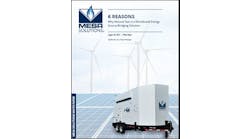Credit: Wikimedia Commons
Microgrids win a new and different kind of public policy support under the carbon-cutting Clean Power Plan announced by the Obama administration this week.
The rule requires that states come up with plans to reduce carbon dioxide emissions from electric power 32 percent below 2005 levels by 2030. That means cutting 870 million tons of carbon from power generation.
To meet these goals, the states are expected to push resources that are key components of many of today’s microgrids: energy storage, renewable energy, combined heat and power, natural gas, fuel cells, demand response, and energy efficiency.
“It will steer us toward where the world is going…” Gina McCarthy.
“This is really going to benefit the microgrid and distributed energy resource business because distributed generation and microgrids are by definition clean,” said Philip Barton, microgrid and reliability program director at Schneider Electric. “Microgrids are a natural for the EPA policy.”
Speeds trends
The new Clean Power Plan adds to a U.S. push for microgrids that is already underway for reasons beyond carbon cutting. The military and several states are incorporating microgrids into their planning to make the power grid more reliable, resilient and secure from cyberattack.
“There is so much distributed generation development going on. There is so much movement in that direction anyway…it’s kind of ahead of the rules, especially in New York,” said Jacob Hollinger, a partner with McDermott Will & Emery.
An earlier draft of the plan was criticized for creating too much change too fast. Some said it could de-stabilize the central grid. So the final rule requires that each state demonstrate in its plan that it has considered reliability issues. The EPA also is giving states more time to meet the requirements. They now begin in 2022, rather than 2020 as proposed in a draft rule last year.
The EPA emphasized that the Clean Power Plan doesn’t so much change energy trends, but accelerates those already underway in states, cities and businesses.
“Our plan will grow and strengthen our economy by sending longer term market signals that will drive innovation and investment,” said EPA Administrator Gina McCarthy. “It will keep energy affordable and reliable. It will steer us toward where the world is going, not looking back at where it’s been. “
Clean Power Plan advances microgrids…but not overnight
None of the change, however, will happen overnight. The states are not required to achieve interim emissions performance rates until 2022-2029 and final rates in 2030.
“Long term huge — increasing market potential for energy storage, ancillary markets and renewable energy, big time. Short-term I don’t think there will be a lot of change outside of the people already looking at change,” said David Chiesa, S&C Electric’s director of commercial & industrial and microgrid market segment.
David Chiesa, S&C Electric
“Long term huge — increasing market potential for energy storage…” — David Chiesa
Energy storage expands the opportunity for demand response to participate in wholesale ancillary markets. And demand response is likely to play a big role in state plans. Hence, energy storage will get a boost — eventually — from the Clean Power Plan.
“Energy storage is going to be able to help with peak shaving applications, demand response applications and also with the proliferation of renewables. That is going to mean more ancillary market participation,” Chiesa said. “It is not only going to affect states but also the ISOs all the way down to the suppliers.”
Grid operators in California, New England, New York, and Texas are holding preliminary hearings and discussions on ancillary markets, he said. “They are positioned to be early movers.”
But overall, the Clean Power Plan’s biggest influence will be felt further out, Chiesa said, and S&C Electric is poised for the long-term play.
“People who are thinking they will make money in the market as a result of the EPA rule today — you are not. You are looking at three to five years before these changes start to have a real impact on the market, barring a few early movers,” he said.
New prospects for solar and CHP
Community solar microgrids are poised for particular growth, given the popularity of the technology and falling solar prices. Navigant Research forecasts the addition of 1.8 GW of community solar, alone, (not necessarily with a microgrid component) over the next five years.
The EPA noted in a preamble to the rule that the solar industry overall has expanded twenty fold since 2009. And renewables, in general, are expected to increase by more than 70 percent from 2013 to 2040 and make up one-third of new generating capacity.
Technologies that incorporate efficient heat also are expected to get a boost. The Clean Power Plan will encourage cities and states to look at upgrades to larger systems. And it will encourage more energy-intensive businesses to seek ways to cut costs and position themselves as good corporate citizens.
Solar Turbines unit, Cornell University
“With the primary goal of the Clean Power Plan to reduce carbon emissions, combined heat and power (CHP) is considered by the EPA to be an effective method to reduce greenhouse gas pollutants due to its excellent overall efficiency,” said Chris Lyons, manager of power generation at Solar Turbines. “The key will be for electric utilities to embrace this as a compliance strategy by working with end users with thermal loads. This will help them retain customers, provide more reliable service options at the same time supporting reductions in their carbon footprints.”
Lyons noted that while natural gas is a low cost fuel choice, CHP plants can be configured to use renewable alternative fuels like landfill gas, digester gas and other biomass and MSW fuels to help mitigate long term fuel supply issues.
What’s Next
“It’s probably the biggest Clean Air Act rule-making in 25 years,” said Hollinger. And as such, it will face litigation that has already been promised by opponents.
“Biggest Clean Air Act rule-making in 25 years.” — Jacob Hollinger
There is a chance the courts will stay the litigation, which would delay the Clean Power Plan until the disputes are resolved. Over the last year, the EPA worked to scrub legal vulnerabilities from the plan, including making a change in the way energy efficiency is handled.
But Hollinger said it is hard to predict what will happen. Court stays are rare. Still an appellate court did delay the Cross-State Air Pollution Rule (CSAPR) that had been scheduled to take effect in 2012. Last year the Supreme Court upheld the rule, which addresses sulfur dioxide and nitrogen oxide that crosses state borders.
For now, the EPA requires that states submit compliance plans by Sept. 6, 2016, unless they seek an extension, in which case the plans are due Sept. 6, 2018. The EPA is providing incentives for states to comply early.
The EPA has created a vast amount of material on the Clean Power Plan, including a 1,500-page preamble and several short fact sheets, which are available here. For more details on what the Clean Power Plan means to energy efficiency, see this Energy Efficiency Markets article.
What do you think the Clean Power Plan will mean to microgrids and distributed energy? Comment below or on our LinkedIn Group, Community Microgrids and Local Energy.







